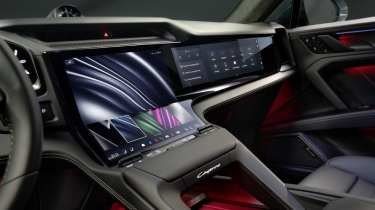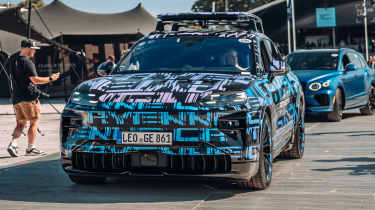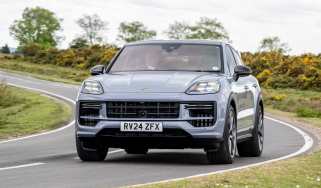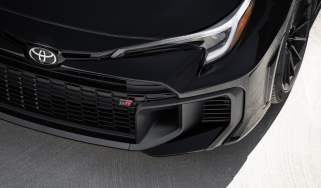New Porsche Cayenne interior revealed – surprise surprise, it’s a pixelfest
The next-generation Cayenne will soon be revealed, with Porsche first showing off a cabin that has more pixels than it has leather
The covers are coming off the next-generation Porsche Cayenne, slowly but surely, with the interior now fully shown-off for the first time. We got a glimpse of what was to come during our testing of the Cayenne’s new wireless charging feature, when the interior disguise fell away revealing a curved central screen. Now it’s fully out in the open, described as the ‘Porsche interior of the future’. Turns out, Porsche’s idea of the interior of the future looks a lot like Piccadilly Circus.
> Porsche officially puts EV plans on hold, developing new petrol models instead
There’s no getting around it. The first thing you notice is that array of touch screens, the most dramatic and novel being the curved central display, what Porsche calls a ‘flow display’. While it's one single unit, software divides the controls, with the lower area able to be controlled independently to the section above. With OLED hardware it’s boasted to be the ‘largest digital surface in any Porsche’ but happily, below it, are some physical controls – toggles for fan speed and temperature. To its right, an optional 14.9-inch passenger display allowing entertainment and access to certain controls. In front of the driver, a new curved display panel with a similar analogue-aping UI with flanking controls a-la the Taycan and Macan.
There’s also the option of an augmented reality head-up display. If you’d wondered what part of Porsche was at the ideological polar opposite end of the company to Andreas Preuninger and his GT department, the place where they design the screens might well be it - although it is a close fight with Porsche Design’s clothing department.
What about the non-digital interior elements? The Porsche Cayenne faithful will for the most part, we think, lament the lack of proper jutting grab handles on the centre console. Instead, a large storage area under the central screen is flanked by prongs of trim burrowing down into what you’d call the transmission tunnel. Porsche is also proud of the surface heating for front seat occupants, spanning the seats, armrests and parts of the door panels.
What do we know about the next iteration of perhaps the ultimate evo tow car? Under the skin it’s expected to feature a comprehensively updated version of the 800-volt PPE platform that first underpinned the Macan EV, called K1. Like the Macan EV, the Cayenne EV is also expected to be sold alongside its internal combustion counterpart, rather than replacing it outright.
Development for the existing petrol and hybrid models is far from over, with Porsche planning ‘major technical investment’ to ensure its internal combustion engined powertrains comply with future EU legislation and it offers a broad range of powertrains to appeal to as broad a customer base as possible.
We don’t know a huge amount about its tech specs yet but it ought to feature a larger battery and more powerful motors, spec for spec, than the Macan. For reference, Porsche’s smaller (but still 2220kg at its lightest) EV SUV features 95kW batteries across the range and gets 380 miles of range in Macan 4 form. Maximum charging rates could meet or exceed the 270kW speeds achieved by the Macan.
What it will feature is the option of wireless charging, as has been previewed. The €7k system (for both the car’s hardware and the pad you drive over) will allow owners to park their Cayennes over a charging pad to be charged at an 11kW rate, without faffing about with plugs, or having to do anything at all really.
The first Porsche Cayenne EVs will, of course, be Cayenne ‘Turbo’ models. As per the Macan and, indeed, the Taycan’s release strategies, big power (more profitable) models come first, followed by the lower-spec versions with less performance and more range that are always the more sensible purchase.
> Best electric cars 2025 – great EVs from hot hatches to supercars
While Porsche is unlikely to be baited into a power struggle with the 905bhp Lotus Eletre R, serious power – up to 800bhp or more – is expected from the most potent ‘Turbo S’ model. That car is likely what we see the interior of here, given the ‘Turbonite’ smoked metallic trim throughout and of the badge.
Expect higher-spec versions of the Cayenne to come with an electronically controlled locking differential on the rear axle, as available on the Macan 4S and Turbo. Rear-wheel steering, air springs and PASM adaptive dampers will also form part of the chassis systems. Rear-wheel steering, air springs and PASM adaptive dampers will also form part of the chassis systems.
Design wise there’s really not a lot to say about the Cayenne Electric. It’s all but sure to take similar cues to the Macan and upside them. We see a blade-like solid rear light and wider, more bulbous light units at the front. Unlike the Macan, it doesn’t appear to have a ‘main’ light unit lower down, separate to the DRL units, instead utilising a more traditional integrated set-up.
The car is set for a full reveal before the end of the year, with sales beginning between Q2 and Q3 2026. The question is, will people buy it?







